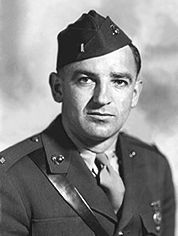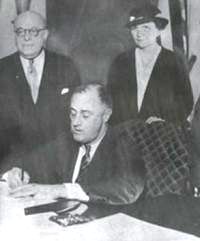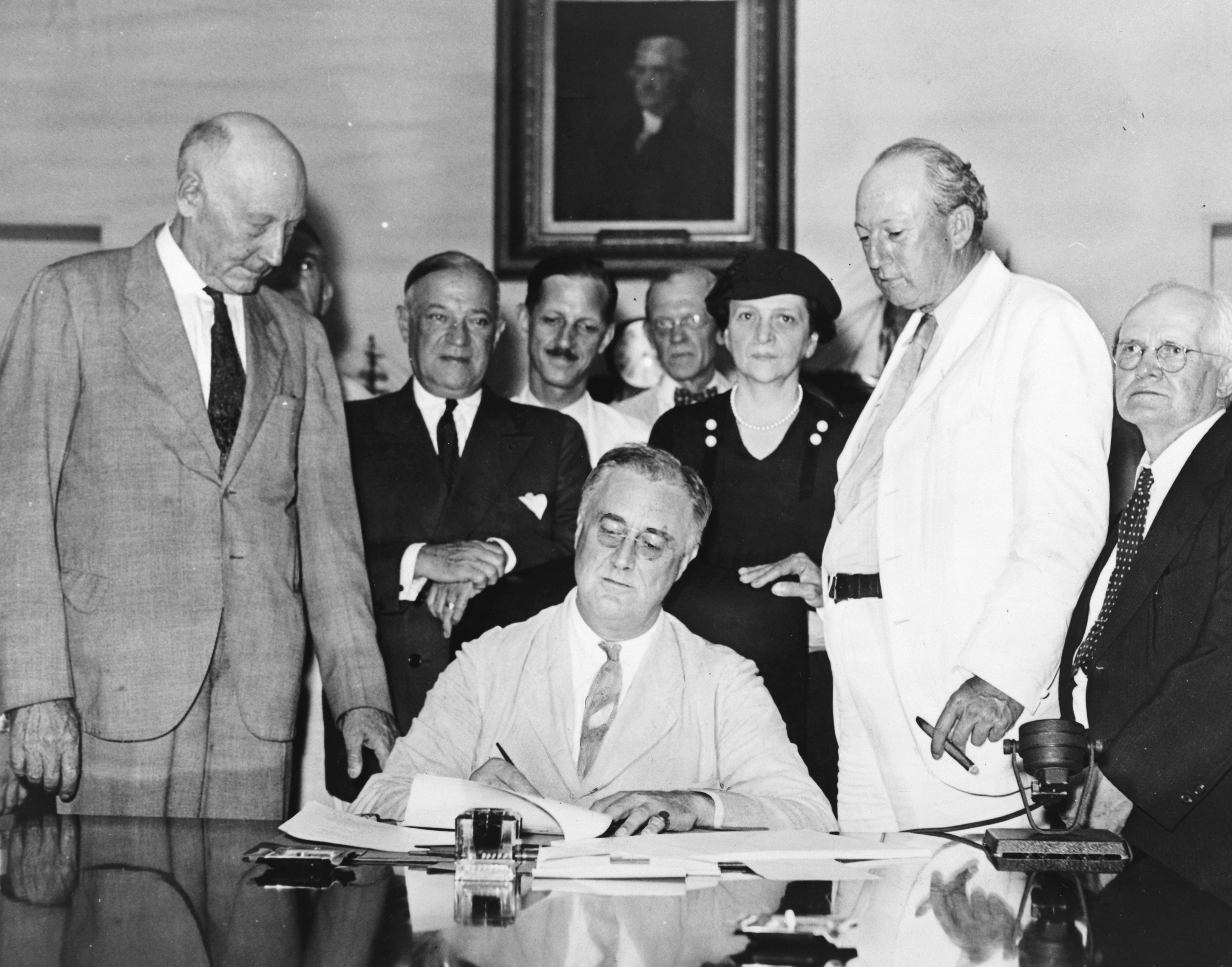|
Leon H. Keyserling
Leon Hirsch Keyserling (January 11, 1908 – August 9, 1987) was an American economist and lawyer who served as chairman of the Council of Economic Advisers from 1950 to 1953. During his tenure, he advised President Harry S. Truman on the economic issues and helped draft major pieces of Fair Deal legislation. Early life Keyserling was born in 1908 in Charleston, South Carolina and grew up on Saint Helena Island. He earned an A.B. from Columbia University in 1928 and a law degree from Harvard Law School in 1931. He returned to Columbia as a graduate student in the Department of Economics from 1931 to 1933, where he also taught for a short time. While there, Keyserling studied under Rexford Tugwell, but never finished his dissertation. Keyserling married Mary Dublin Keyserling, also an economist. Government career In 1933 Keyserling became an attorney for the newly constituted Agricultural Adjustment Administration, a New Deal agency that distributed subsidies to reduce crop a ... [...More Info...] [...Related Items...] OR: [Wikipedia] [Google] [Baidu] |
Council Of Economic Advisers
The Council of Economic Advisers (CEA) is a United States agency within the Executive Office of the President established in 1946, which advises the President of the United States on economic policy. The CEA provides much of the empirical research for the White House and prepares the publicly-available annual Economic Report of the President. Activities Economic Report of the President The report is published by the CEA annually in February, no later than 10 days after the Budget of the US Government is submitted. The president typically writes a letter introducing the report, serving as an executive summary and used for press coverage. The report proceeds with several hundred pages of qualitative and quantitative research by reviewing the impact of economy, economic activity in the previous year, outlining the economic goals for the coming year (based on the President's economic agenda), and making numerical projections of economic performance and outcomes. Public criticism ... [...More Info...] [...Related Items...] OR: [Wikipedia] [Google] [Baidu] |
New Deal
The New Deal was a series of programs, public work projects, financial reforms, and regulations enacted by President Franklin D. Roosevelt in the United States between 1933 and 1939. Major federal programs agencies included the Civilian Conservation Corps (CCC), the Works Progress Administration (WPA), the Civil Works Administration (CWA), the Farm Security Administration (FSA), the National Industrial Recovery Act of 1933 (NIRA) and the Social Security Administration (SSA). They provided support for farmers, the unemployed, youth, and the elderly. The New Deal included new constraints and safeguards on the banking industry and efforts to re-inflate the economy after prices had fallen sharply. New Deal programs included both laws passed by Congress as well as presidential executive orders during the first term of the presidency of Franklin D. Roosevelt. The programs focused on what historians refer to as the "3 R's": relief for the unemployed and for the poor, recovery of ... [...More Info...] [...Related Items...] OR: [Wikipedia] [Google] [Baidu] |
Joseph McCarthy
Joseph Raymond McCarthy (November 14, 1908 – May 2, 1957) was an American politician who served as a Republican U.S. Senator from the state of Wisconsin from 1947 until his death in 1957. Beginning in 1950, McCarthy became the most visible public face of a period in the United States in which Cold War tensions fueled fears of widespread communist subversion. He is known for alleging that numerous communists and Soviet spies and sympathizers had infiltrated the United States federal government, universities, film industry, and elsewhere. Ultimately, he was censured for refusing to cooperate with, and abusing members of, the committee established to investigate whether or not he should be censured. The term "McCarthyism", coined in 1950 in reference to McCarthy's practices, was soon applied to similar anti-communist activities. Today, the term is used more broadly to mean demagogic, reckless, and unsubstantiated accusations, as well as public attacks on the character or p ... [...More Info...] [...Related Items...] OR: [Wikipedia] [Google] [Baidu] |
National Labor Relations Act
The National Labor Relations Act of 1935, also known as the Wagner Act, is a foundational statute of United States labor law that guarantees the right of private sector employees to organize into trade unions, engage in collective bargaining, and take collective action such as strikes. Central to the act was a ban on company unions. The act was written by Senator Robert F. Wagner, passed by the 74th United States Congress, and signed into law by President Franklin D. Roosevelt. The National Labor Relations Act seeks to correct the "inequality of bargaining power" between employers and employees by promoting collective bargaining between trade unions and employers. The law established the National Labor Relations Board to prosecute violations of labor law and to oversee the process by which employees decide whether to be represented by a labor organization. It also established various rules concerning collective bargaining and defined a series of banned unfair labor practices, in ... [...More Info...] [...Related Items...] OR: [Wikipedia] [Google] [Baidu] |
Social Security Act
The Social Security Act of 1935 is a law enacted by the 74th United States Congress and signed into law by US President Franklin D. Roosevelt. The law created the Social Security program as well as insurance against unemployment. The law was part of Roosevelt's New Deal domestic program. By the 1930s, the United States was the only modern industrial country without any national system of social security. In the midst of the Great Depression, the physician Francis Townsend galvanized support behind a proposal to issue direct payments to the elderly. Responding to that movement, Roosevelt organized a committee led by Secretary of Labor Frances Perkins to develop a major social welfare program proposal. Roosevelt presented the plan in early 1935 and signed the Social Security Act into law on August 14, 1935. The act was upheld by the Supreme Court in two major cases decided in 1937. The law established the Social Security program. The old-age program is funded by payroll taxes, an ... [...More Info...] [...Related Items...] OR: [Wikipedia] [Google] [Baidu] |
National Industrial Recovery Act
The National Industrial Recovery Act of 1933 (NIRA) was a US labor law and consumer law passed by the 73rd US Congress to authorize the president to regulate industry for fair wages and prices that would stimulate economic recovery. It also established a national public works program known as the Public Works Administration (PWA). The National Recovery Administration (NRA) portion was widely hailed in 1933, but by 1934 business opinion of the act had soured. The legislation was enacted in June 1933 during the Great Depression as part of President Franklin D. Roosevelt's New Deal legislative program. Section 7(a) of the bill, which protected collective bargaining rights for unions, proved contentious (especially in the Senate). Congress eventually enacted the legislation and President Roosevelt signed the bill into law on June 16, 1933. The Act had two main titles . Title I was devoted to industrial recovery, authorizing the promulgation of industrial codes of fair compet ... [...More Info...] [...Related Items...] OR: [Wikipedia] [Google] [Baidu] |
National Housing Agency
The United States Department of Housing and Urban Development (HUD) is one of the executive departments of the U.S. federal government. It administers federal housing and urban development laws. It is headed by the Secretary of Housing and Urban Development, who reports directly to the President of the United States and is a member of the president's Cabinet. Although its beginnings were in the House and Home Financing Agency, it was founded as a Cabinet department in 1965, as part of the "Great Society" program of President Lyndon B. Johnson, to develop and execute policies on housing and metropolises. History The idea of a department of Urban Affairs was proposed in a 1957 report to President Dwight D. Eisenhower, led by New York Governor Nelson A. Rockefeller. The idea of a department of Housing and Urban Affairs was taken up by President John F. Kennedy, with Pennsylvania Senator and Kennedy ally Joseph S. Clark Jr. listing it as one of the top seven legislative prioritie ... [...More Info...] [...Related Items...] OR: [Wikipedia] [Google] [Baidu] |
Federal Public Housing Authority
The United States Housing Authority, or USHA, was a Alphabet agencies, federal agency created during 1937 within the United States Department of the Interior by the Housing Act of 1937 as part of the New Deal. It was designed to lend money to the states or communities for low-cost construction. History Units for about 650,000 low-income people, but mostly for the homeless, were started. Progressivism in the United States, Progressives early in the 20th century had argued that improving the physical environment of poorer citizens would improve their quality of life and chances for success (and cause better social behavior). As governor of New York (state), New York, Al Smith began public housing programs for low-income employed workers. US Senator Robert F. Wagner (D-New York) carried those beliefs into the 1930s, when he was a power in the United States Congress. From 1933-37, the Public Works Administration (PWA) under Harold L. Ickes, Harold Ickes razed 10,000 slum units and b ... [...More Info...] [...Related Items...] OR: [Wikipedia] [Google] [Baidu] |


